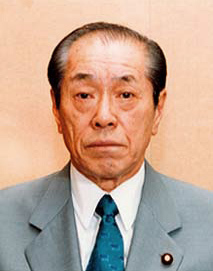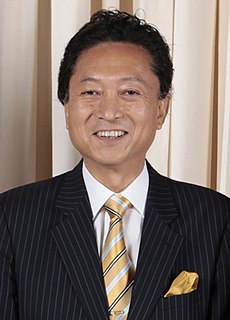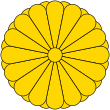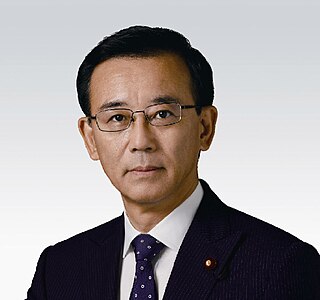
Shōichi Nakagawa was a Japanese conservative politician in the Liberal Democratic Party (LDP), who served as Minister of Finance from 24 September 2008 to 17 February 2009. He previously held the posts of Minister of Economy, Trade and Industry and Ministry of Agriculture, Forestry and Fisheries in the cabinet of Junichiro Koizumi. He was regarded as one of Japan's most attractive public figures. On 4 October 2009, he was found dead in his Tokyo apartment. The cause of his death is yet to be determined; although no suicide note was found, there was also no indication of foul play.

Yōhei Kōno is a Japanese politician and a former President of the Liberal Democratic Party. He served as Speaker of the House of Representatives from November 2003 until August 2009, when the LDP lost its majority in the 2009 election. Kōno served as speaker for the longest length since the set up of House of Representatives in 1890. He was the president of the Japan Association of Athletics Federations from 1999 to 2013.

Tarō Asō is a Japanese politician who is the Deputy Prime Minister and Minister of Finance. Asō was the 59th Prime Minister of Japan, serving from September 2008 to September 2009. He was also a member of the Japanese shooting team at the 1976 Montreal Olympics.

Nariaki Nakayama is a Japanese politician. He served as Minister of Education, Culture, Sports, Science and Technology in the Cabinet of Junichiro Koizumi and later as Minister of Land, Infrastructure, Transport and Tourism under Tarō Asō. After only four days in office he resigned due to a series of gaffes. Appointed on 24 September 2008, he resigned on 28 September 2008. After being de-endorsed by the LDP he lost his seat in the 2009 general election, eventually returning to the diet as a member of the Japan Restoration Party in the 2012 general election. He lost his seat again in the 2014 general election.

Yasuo Fukuda was the 58th Prime Minister of Japan, serving from 2007 to 2008. He was previously the longest-serving Chief Cabinet Secretary in Japanese history, serving for three and a half years (2000–2004) under Prime Ministers Yoshirō Mori and Junichiro Koizumi.

Bunmei Ibuki is a Japanese politician. He is a Member of the House of Representatives serving the constituency of Kyoto Prefecture, 1st district, where, as of October 2006, he has been elected eight times. He was the Secretary General of Japan's Liberal Democratic Party from 2007 to 2008. In 2008, he was briefly Minister of Finance.

Hiromu Nonaka was a Japanese LDP politician. He served as a local politician from 1951 to 1978 and in the House of Representatives from 1983 to 2003, becoming one of its most prominent members in the 1990s. He served as Minister of Home Affairs and Head of the National Public Safety Commission from 1994 to 1995, as Chief Cabinet Secretary from 1998 to 1999, and as Head of the Okinawa Development Agency in 1999. Nonaka was widely considered as a voice of reason within the LDP.

Kaoru Yosano was a Japanese politician. He was a member of the Liberal Democratic Party (LDP), the Sunrise Party of Japan and former member of the House of Representatives, serving his ninth term in the Lower House representing Tokyo's first electoral district until his defeat in the Japanese general election, 2009. Yosano was Chief Cabinet Secretary to Prime Minister Shinzō Abe from August 2007 to September 2007 and was Minister of Economic and Fiscal Policy in Tarō Asō's administration from February to September 2009.
A leadership election was held in the Liberal Democratic Party of Japan on 23 September 2007 after the incumbent party leader and Prime Minister of Japan Shinzō Abe announced that he would resign on 12 September 2007. Abe had only been elected to the post slightly less than a year earlier; his resignation came only three days after a new parliamentary session had begun. Abe said his unpopularity was hindering the passage of an anti-terrorism law, involving among other things Japan's continued military presence in Afghanistan. Party officials also said the embattled Prime Minister was suffering from poor health.
A leadership election was held in the Liberal Democratic Party of Japan on 20 September 2006 after the incumbent party leader and Prime Minister Junichiro Koizumi announced his intention to resign, a year after he led the party to victory in a snap election. Shinzō Abe won the election,. His chief competitors for the position were Sadakazu Tanigaki and Taro Aso. Yasuo Fukuda was a leading early contender, but ultimately chose not to run. Former Prime Minister Yoshirō Mori, to whose faction both Abe and Fukuda belonged, stated that the faction strongly leant toward Abe. Abe was subsequently elected Prime Minister with 339 of 475 votes in the Diet's lower house and a majority in the upper house.
Chuko Hayakawa is a Japanese attorney who previously served as a Liberal Democratic Party (LDP) member of the House of Representatives in the Diet.

Tarō Kōno is a Japanese politician belonging to the Liberal Democratic Party. He is a member of the House of Representatives, and has served as Minister for Foreign Affairs since a Cabinet re-shuffle by Prime Minister Shinzō Abe on 3 August 2017.

A general election for the Japanese House of Representatives was held on August 30, 2009. The opposition Democratic Party (DPJ) defeated the ruling coalition in a sweeping victory, winning 221 of the 300 electoral districts and receiving 42.4% of the proportional block votes for another 87 seats, a total of 308 seats to only 119 for the LDP.

A leadership election was held in the Liberal Democratic Party of Japan on 22 September 2008 after the incumbent party leader and Prime Minister of Japan Yasuo Fukuda announced that he would resign on 1 September 2008, only 11 months after taking office on 25 September 2007 following a leadership election on 23 September 2007. Taro Aso, who had lost to Fukuda in the 2007 leadership election, was widely seen as the frontrunner to replace him, and announced on 2 September 2008 he was ready to take over as party leader. Aso won the leadership election against four opponents, receiving 67% of the vote.
Prefectural elections for the Tokyo Metropolitan Assembly were held on 12 July 2009. In the runup to the Japanese general election due by October they were seen as an important test for Taro Aso's ruling coalition of the Liberal Democratic Party (LDP) and the New Komeito. New Komeito considers Tokyo as an important stronghold and had repeatedly asked Prime Minister Aso to avoid holding the two elections within a month of each other.

The 22nd Elections to the House of Councillors for the upper house of the legislature of Japan were held on July 11, 2010. In the last election in 2007, the Liberal Democratic Party (LDP) lost its majority to the Democratic Party (DPJ), which managed to gain the largest margin since its formation in 1996. The House of Councillors is elected by halves to six-year terms. The seats up for election in 2010 were last contested in the 2004 election.

Yamaguchi 4th district is a single-member electoral district for the House of Representatives, the lower house of the National Diet of Japan. It is located in Western Yamaguchi and consists of the cities of Shimonoseki and Nagato. As of September 2011, 266,456 voters were registered in the district, giving its voters well above average vote weight. Unlike many prefectures where the capital is also the most populous city, Yamaguchi's major city is Shimonoseki, located at the western tip of Honshū and part of the Fukuoka-Kitakyūshū metropolitan area.
A leadership election was held on 20 September 2018 to elect the next president of the Liberal Democratic Party of Japan for a new 3-year term. Incumbent president Shinzō Abe was running for re-election after a rule change in 2017 that allowed him to run for a third term.






















